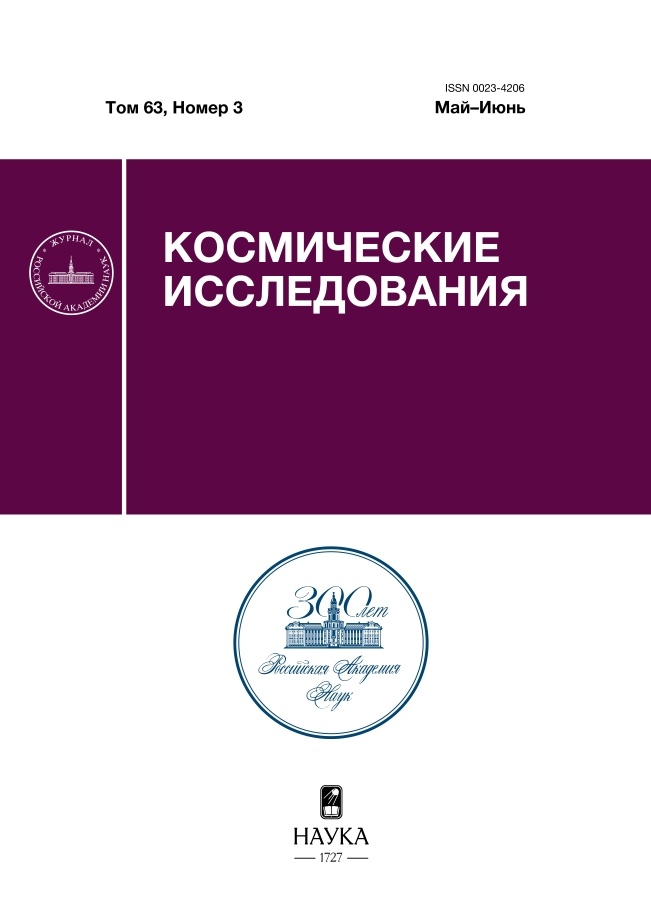Gravispheric effect for flights between the Earth and high lunar orbit
- Authors: Murtazin R.F.1, Zaborsky S.A.1, Belyaeva E.K.1, Suprunov Y.V.1
-
Affiliations:
- Rocket-Space Corporation Energia
- Issue: Vol 63, No 3 (2025)
- Pages: 294-306
- Section: Articles
- URL: https://jdigitaldiagnostics.com/0023-4206/article/view/689533
- DOI: https://doi.org/10.31857/S0023420625030079
- EDN: https://elibrary.ru/QAANIP
- ID: 689533
Cite item
Abstract
The article considers a variant of the lunar transportation system using an orbital station deployed in a stable high circumlunar orbit. The insignificant size of the Moon's gravisphere, in terms of planetary scales, allows us to consider the problem of near-lunar maneuvers in a new way. Rational use of gravitational perturbation from the Earth during the flight in the boundary vicinity of the Moon's gravisphere, reduces the cost of spacecraft delivery from the Earth to the high lunar orbit, where it is proposed to place the lunar orbital station. This approach is called the “gravispheric” effect, which is particularly well manifested in flights to high lunar orbit. The paper shows the mathematical description of the gravisphere effect and examples of its use in flights between the Earth and high lunar orbit obtained by the authors.
Full Text
About the authors
R. F. Murtazin
Rocket-Space Corporation Energia
Email: ketti-g67@mail.ru
Department of space ballistic
Russian Federation, Korolev, Moscow regionS. A. Zaborsky
Rocket-Space Corporation Energia
Email: ketti-g67@mail.ru
Department of space ballistic
Russian Federation, Korolev, Moscow regionE. K. Belyaeva
Rocket-Space Corporation Energia
Author for correspondence.
Email: ketti-g67@mail.ru
Department of space ballistic
Russian Federation, Korolev, Moscow regionYu. V. Suprunov
Rocket-Space Corporation Energia
Email: ketti-g67@mail.ru
Russian Federation, Korolev, Moscow region
References
- Легостаев В.П., Лопота В.А. Луна – шаг к технологиям освоения Солнечной системы. М.: РКК “Энергия”, 2011. 584 с.
- Решение Президиума Научно-технического совета Госкорпорации “Роскосмос” и Бюро Совета Российской академии наук по космосу по вопросу: “Концепция российской комплексной программы исследования и освоения Луны”. М., 2018. 6 с. http://sovet.cosmos.ru/
- Макушенко Ю.Н., Муртазин Р.Ф., Зарубин Д.С. Космический порт для доставки экипажа на поверхность Луны // Космическая техника и технологии. 2019. № 2(25). С. 5–13.
- Основы государственной политики Российской Федерации в области космической деятельности на период до 2030 года и дальнейшую перспективу, утвержденные Президентом Российской Федерации 19 апреля 2013 года (№ Пр-906). http://www.roscosmos.ru›media/files/docs/3/osnovi_do_2030.doc
- Grebow D.J., Ozimek M.T., Howell K.C. et al. Multibody orbit architectures for lunar South Pole coverage // J. Spacecraft and Rockets. 2008. V. 45. Iss. 2. P. 344–358.
- Whitley R., Martinez R. Options for Staging Orbits in Cis-Lunar Space // Aerospace Conference IEEE. Big Sky, MT, USA. 2016. Art.ID. 9.
- Левантовский В.И. Механика космического полета в элементарном изложении. М.: Наука, 1980. 512 с.
- Tselousova A., Shirobokov M., Trofimov S. High-Altitude Near-Circular Orbits for a Lunar Orbital Station // Proc. IAA-SciTech Forum. Russia, Moscow. 2018. P. 41–52.
- Муртазин Р.Ф. Эффективное выведение КА на высокую круговую окололунную орбиту // Космонавтика и ракетостроение. 2019. № 3 (108). С. 5–12.
- Гордиенко Е.С., Ивашкин В.В. Использование трехимпульсного перехода для выведения космического аппарата на орбиты искусственного спутника Луны // Косм. исслед. 2017. Т. 55. № 3. С. 207–217.
- Охоцимский Д.Е., Сихарулидзе Ю.Г. Основы механики космического полета. Наука, 1990. 448 с.
- Лидов М.Л. Эволюция орбит искусственных спутников под воздействием гравитационных возмущений внешних тел // Искусственные спутники Земли. 1961. Т. 8. С. 5–45.
- Эльясберг П.Е. Введение в теорию полета искусственных спутников Земли. М: Наука, 1965. 540 с.
- Нариманов Г.С. Основы теории полета космических аппаратов. М.: Машиностроение, 1972. 612 с.
Supplementary files





















